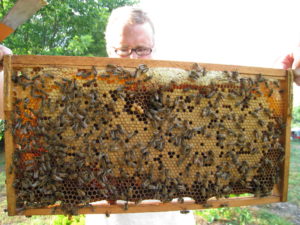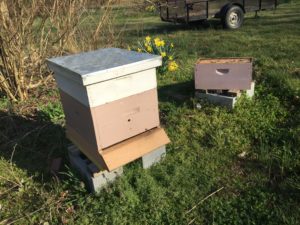Spring Splits
This year, my main focus is increase. Due to the higher than normal losses over the past 6 months! So far, the stars have aligned nicely for this goal, as I have been able to create around 15 Nuc’s over the past couple of weeks.
It seems that many folks call a “Nuc” a Spring Split. For me, any split is dividing the frames in a mature hive evenly among two hives. I usually tackle splits (if I do ’em) in late April and early May, during a full on Flow. Regardless, this is the perfect time for me to create a Nuc (or Split!) in areas just to the east of Richmond, Va.

Starting in March, I begin to gauge my hives – usually during the Spring clean-up (scraping frames and bottom boards, re-leveling, etc..) But, oftentimes I am simply pulling off the boxes until I get to the bottom deep and pulling a few frames in the center of the deep. My rule is to only pull a Nuc when the weather is right and the colony is at least working a few frames in the bottom deep. By gauging my hives in mid-March, I can usually tell when to next check them for possibly Nuc creation.
Once I identify the target colony, I need to find the queen. In fact, regardless of whether I take a Nuc or not, I make it an absolute must to find all queens by April 1 (and mark them). In this way, I know that any unmarked queen is last year’s queen – I have probably marked 10 white queens this Spring (the rest were either already white or even green and blue – I actually noted one Red queen, but once I realized that queen had to be from 2013, I wonder if I didn’t see some pollen or something….need to find that queen again!) I then place the frame with the queen off to the side, leaning up against the hive. It’s now work time!
The Nuc is a 5-framer. If I am creating a Deep Nuc (colony is working 5 or 6 frames), I move 3 frames to the Nuc (the remaining two are either already drawn frames or with foundation). I make sure that a frame with eggs is dead center in the Nuc. Once the frames are squared, I then shake 3 frames of bees onto the top of the Nuc frames. Lots fall on the ground, but they make their way back to the Nuc. Once done, I put the top on the Nuc and let her be for 3 weeks (it should be noted that I create all of my Nucs within 50′ of the parent hive – most times within 10′, and that’s where they stay).
For Medium Nucs, I have found that I need 4 frames from the parent hive. I also create most of them a bit later in the season (usually mid-April.) I may have 3 out there right now, but will create quite a few more in a week or two.
Once the Nuc is created, I let it sit for 3 weeks. By then, they will have raised and hatched a new queen, so I am ONLY actively looking for an open queen cell or two. If I do not see that, they receive another frame of eggs and I make a note to check again in 3 weeks. Once I see an open queen cell, I return in 2 weeks to find either evidence of a queen (eggs, larvae) or the queen herself. They get another frame of eggs if I don’t find one of these things, otherwise I note that we have a laying queen and come back 2 weeks later to mark the queen and take action on the Nuc (sell, convert to full hive, move, etc…)
These are the Split/Nuc creation basics. In some cases, I take several Nucs from the same hive. Some queens seem hell bent on growing like gangbusters. I will continue to revisit these hives, sometimes one week apart, creating a new Nuc each time. But, I never put the bees at jeopardy. I only do this with my really strong hives. They seem focused on building up to swarm, so I take advantage of this growth until they actually do.

 The first hive inspections of the year are always an adventure of up’s and down’s, although “inspection” is a strong word for it. Typically, I am going to 3 or 4 yards, checking hive weight (lifting the back of hive) and pulling off each super and/or brood chamber until I get to the bottom box and then I level her out for the year. Finally, I remove the entrance reducer if one was placed on her last Fall.
The first hive inspections of the year are always an adventure of up’s and down’s, although “inspection” is a strong word for it. Typically, I am going to 3 or 4 yards, checking hive weight (lifting the back of hive) and pulling off each super and/or brood chamber until I get to the bottom box and then I level her out for the year. Finally, I remove the entrance reducer if one was placed on her last Fall.